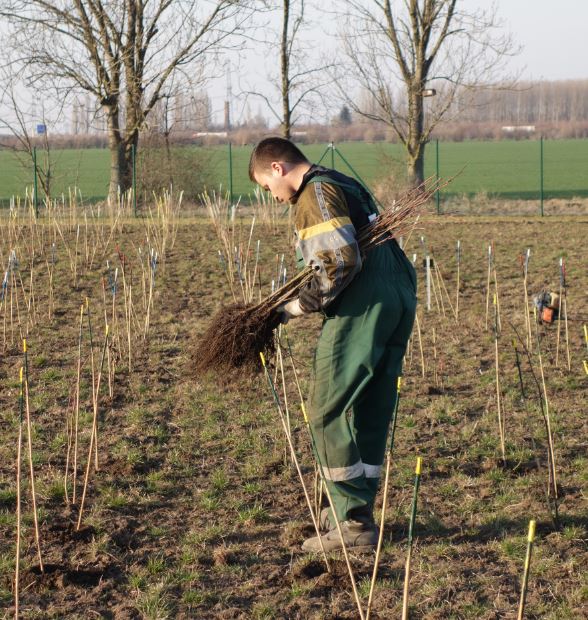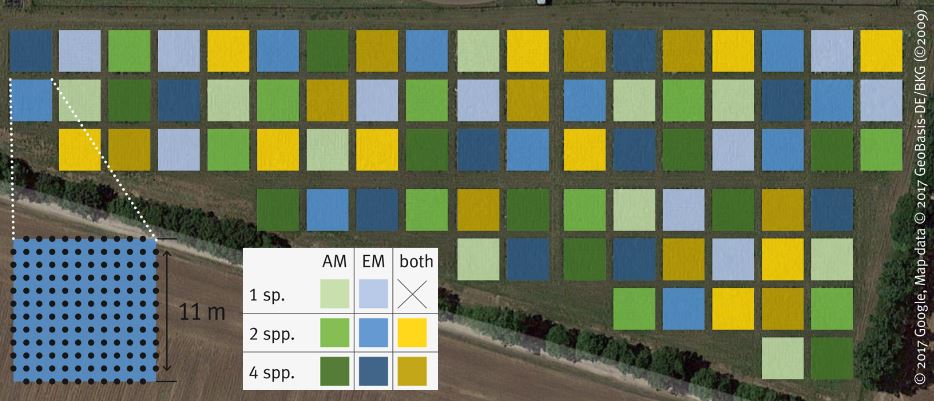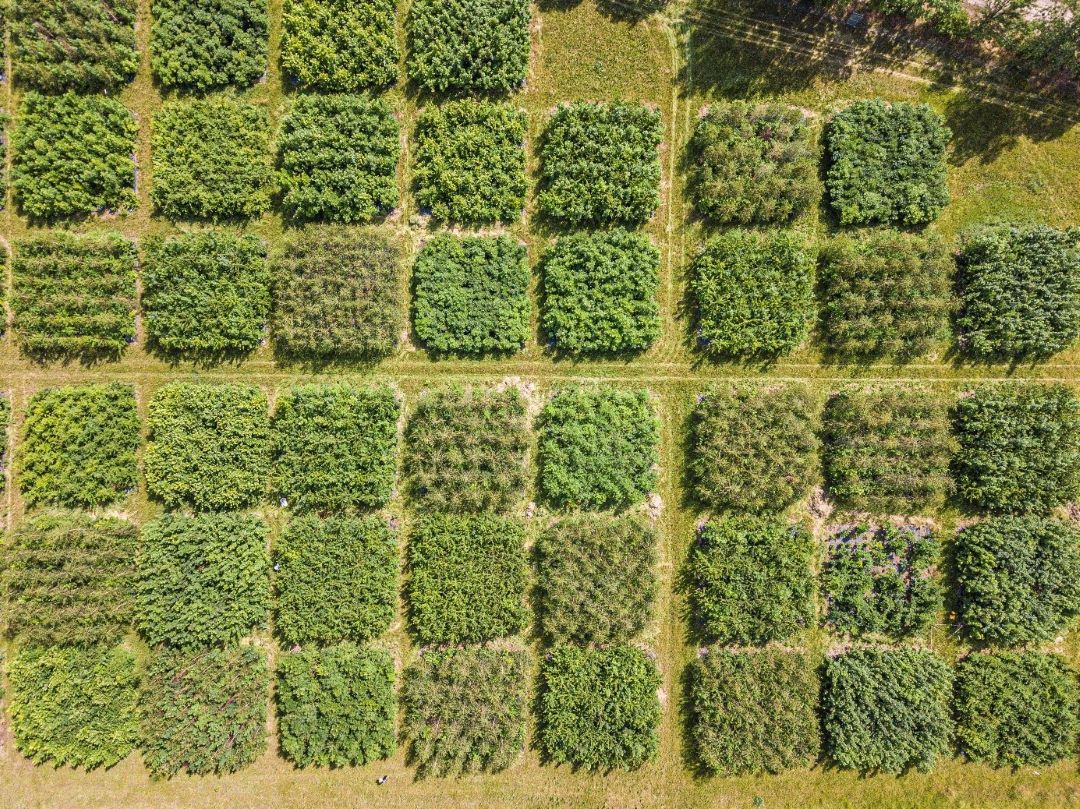MyDiv (Germany)
MyDiv stands for Mycorrhizae in tree Diversity effects on ecosystem functioning and trophic interactions. It is a tree diversity experiment planted in Bad Lauchstädt (near Halle, Central Germany) in March 2015. The experiment aims to investigate the significance of aboveground-belowground interactions in tree diversity effects on ecosystem functioning. More specifically, the effects of different mycorrhizal associations on a variety of ecosystem functions and soil food webs are studied.

Design
The experiment comprises ten native angiosperm tree species: five that develop associations with arbuscular mycorrhiza (AM) and five that develop associations with ectomycorrhiza (EM). Tree species selection aimed at achieving the highest functional similarity between the two pools with regard to tree height, wood density, specific leaf area, seed mass, leaf C:N ratio, and leaf-out date.
The species were planted in monocultures, 2-species, and 4-species mixtures. At each of the tree diversity levels, communities with only AM, with only EM, or with mixtures of both tree species pools were established. The treatments were randomly distributed within two blocks. The experimental design followed the broken-stick model ending up in five different species combinations per block in all treatments. As the species pool contained more species (5 species) than the highest diversity level (4 species), it is possible to test tree diversity effects without confounding effects of compositional similarity at high tree diversity.
Each plot consists of 140 tree individuals with a planting distance of 1 m. Tree individuals of 2- and 4-species mixtures were planted in a regular distribution pattern with each species being represented in the same proportion. All plots had been covered with black water-permeable polypropylene tarp to reduce competition with weeds and the establishment of rodent habitats at the beginning of the experiment; the black tarp was removed after the successful establishment of the experimental plots and a nearly full canopy closure in autumn 2022.


Site characteristics
| MyDiv (Bad Lauchstädt) | |
|---|---|
| Country | Germany |
| Biome | temperate |
| Latitude | 51.39 |
| Longitude | 11.88 |
| Soil type | Haplic Chernozem developed from Loess (WRB) |
| Former land use | agriculture |
| Altitude | 115 m |
| Design | stem-wise regular |
| Plot shape | square |
| Plot size (m^2) | 121 m² |
| Plant distance (m) | 1 |
| Number of trees planted | 11 200 |
| Planting date | March 2015 |
| Diversity variables | species richness mycorrhizal type |
| Diversity gradient | 1, 2, 4 sp. AM, EM, AM+EM trees |
| Size species pool | 10 |
| Species pool | Acer pseudoplatanus Aesculus hippocastanum Fraxinus excelsior Prunus avium Sorbus aucuparia Betula pendula Carpinus betulus Fagus sylvatica Quercus petraea Tilia platyphyllos |
| Contact person | Olga Ferlian Nico Eisenhauer |
| olga.ferlian@idiv.de nico.eisenhauer@idiv.de |
Research
Mycorrhizae play a critical role in plant nutrient and water uptake from soil and, consequently, in the plants’ competitive capabilities as well as in nutrient cycling of the whole system. The positive relationship between biodiversity and ecosystem functioning can be mainly attributed to the complementary use of soil resources. The type of mycorrhizal association may, therefore, affect complementarity among plant species. In MyDiv, we test how biodiversity-ecosystem functioning relationships differ among tree communities of different mycorrhizal types. We expect tree communities of high species richness and with both mycorrhizal types to have the strongest biodiversity-ecosystem functioning relationship. Furthermore, mycorrhizal fungi serve as an important food source for the belowground fauna. However, the roles of the two major mycorrhizal types within the soil food web are still poorly understood.
The main studies will focus on the effects on tree growth and mortality, primary productivity, carbon sequestration, and nutrient cycling as well as on trophic interactions in soil including diversity and structure of soil microbial and soil fauna communities.
Extra information
Send an e-mail to the contact persons, visit the experiment’s own website, or explore the publications that utilized data from this experiment.
Research papers
- Augusto L, Borelle R, Boča A, Bon L, Orazio C, Arias-González A, Bakker MR, Gartzia-Bengoetxea H, Bernier AF, Cantero A, Cavender-Bares J, Correia AH, De Schrijver A, Diez-Casero JJ, Eisenhauer N, Fotelli MN, Gâteblé G, Godbold DL, Gomes-Caetano-Ferreira, Gundale MJ, Jactel H, Koricheva J, Larsson M, Laudicina VA, Legout A, Martín-García J, Mason WL, Meredieu C, Mereu S, Montgomery RA, Musch B, Muys B, Paillassa E, Paquette A, Parker JD, Parker WC, Ponette Q, Reynolds C, Rozados-Lorenzo MJ, Ruiz-Peinado R, Santesteban-Insausti X, Scherer-Lorenzen M, Silva-Pando FJ, Smolander A, Spyroglou G, Teixeira-Barcelos EB, Vanguelova EI, Verheyen K, Vesterdal L, Charru M 2025 Widespread slow growth of acquisitive tree species. Nature 640: 395–401 - doi: 10.1038/s41586-025-08692-x
- Köhler M, Hähn G, Kanitz M, Ferlian O, Eisenhauer N, Wubet T, Bruelheide H 2025 The effects of tree diversity and neighborhood on phyllosphere fungal communities. Fungal Ecology 76: 101440 – doi: 10.1016/j.funeco.2025.101440
- Ul Haq H, Hauer A, Singavarapu B, Christel H, Cesarz S, Eisenhauer N, Ferlian O, Bruelheide H, Wubet T 2025 The interactive effect of tree mycorrhizal type, mycorrhizal type mixture and tree diversity shapes rooting zone soil fungal communities in temperate forest ecosystems. Functional Ecology 39 (6): 1441-1454 - doi.org/10.1111/1365-2435.14651
- Ul Haq H, Singavarapu B, Hauer A, Eisenhauer N, Ferlian O, Bruelheide H, Wubet T 2025 Temperate forest soil microbiomes and their assembly processes are modulated by the interplay of co‐existing tree species identity, diversity and their mycorrhizal type. Journal of Sustainable Agriculture and Environment 4, e70064 - doi: 10.1002/sae2.70064
- Yi H, Ferlian O, Gauzens B, Rebollo R, Scheu S, Amyntas A, Ciobanu M, Potapov A, Salamon J-A, Eisenhauer N 2025 Belowground energy fluxes determine tree diversity effects on above- and belowground food webs. Current Biology 35: 1870-1882 – doi: 10.1016/j.cub.2025.03.034
- Blondeel H, Guillemot J, Martin‐StPaul N, Druel A, Bilodeau‐Gauthier S, Bauhus J, … Baeten L 2024 Tree diversity reduces variability in sapling survival under drought. Journal of Ecology 112(5): 1164-1180 - https://doi.org/10.1111/1365-2745.14294
- Bönisch E, Blagodatskaya E, Dirzo R, Ferlian O, Fichtner A, Huang Y, Leonard S.J, Maestre F.T, von Oheimb G, Ray T, Eisenhauer N 2024 Mycorrhizal type and tree diversity affect foliar elemental pools and stoichiometry. New Phytologist (242), 1614-1629
- Castro Sánchez‐Bermejo P, Monjau T, Goldmann K, Ferlian O, Eisenhauer N, Bruelheide H, Ma Z, Haider S 2024 Tree and mycorrhizal fungal diversity drive intraspecific and intraindividual trait variation in temperate forests: Evidence from a tree diversity experiment. Functional Ecology (38), 1089-1103.
- Ferlian O, Goldmann K, Bonkowski M, Dumack K, Wubet T, Eisenhauer N 2024 Invasive earthworms shift soil microbial community structure in northern North American forest ecosystems. iScience (27): 108889
- Kattenborn T, Wieneke S, Montero D, Mahecha M D, Richter R, Guimarães-Steinicke C, Wirth C, Ferlian O, Feilhauer H, Sachsenmaier L, Eisenhauer N, Dechant B 2024 Temporal dynamics in vertical leaf angles can confound vegetation indices widely used in Earth observations. Communications Earth & Environment 5:550 - doi: 10.1038/s43247-024-01712-0
- Luo S, Schmid B, Hector A, Scherer‐Lorenzen M, Verheyen K, Barsoum N, Bauhus J, Beyer F, Bruelheide H, Ferlian O, Godbold D, Hall JS, Hajek P, Huang Y, Hölscher D, Kreft H, Liu X, Messier C, Nock C, Paquette A, Parker JD, Parker WC, Paterno GB, Reich PB, Rewald B, Sandén H, Sinacore K, Stefanski A, Willams L, Eisenhauer N 2024 Mycorrhizal associations modify tree diversity− productivity relationships across experimental tree plantations. New Phytologist 243:1205-1219 - doi: 10.1111/nph.19889
- Sachsenmaier L, Schnabel F, Dietrich P, Eisenhauer N, Ferlian O, Quosh J, Ronny Richter, Wirth C 2024 Forest growth resistance and resilience to the 2018–2020 drought depend on tree diversity and mycorrhizal type. Journal of Ecology 112 (8): 1787-1803 - doi.org/10.1111/1365-2745.14360
- Yi H, Eisenhauer N, Austen JC, Rebollo R, Ray T, Bönisch E, von Oheimb G, Fichtner A, Schuldt A, Patoine G, Ferlian O 2024 Tree diversity and mycorrhizal type co‐determine multitrophic ecosystem functions. Journal of Ecology 112(3): 528-546
- Zheng L, Barry KE, Guerrero-Ramírez NR, Craven D, Reich PB, Verheyen K, … Hautier Y 2024 Effects of plant diversity on productivity strengthen over time due to trait-dependent shifts in species overyielding. Nature communications 15(1): 2078 - https://doi.org/10.1038/s41467-024-46355-z
- Depauw L, De Lombaerde E, Dhiedt E, Blondeel H, Abdala-Roberts L, Auge H, Barsoum N, Bauhus J, Chu C, Damtew A, Eisenhauer N, V. Fagundes M, Ganade G, Gendreau-Berthiaume B, Godbold D, Gravel D, Guillemot J, Hajek P, Hector A, Hérault B, Jactel H, Koricheva J, Kreft H, Liu X, Mereu S, Messier C, Muys B, Nock CA, Paquette A, Parker JD, Parker WC, Paterno, GB, Perring MP, Ponette Q, Potvin C, Reich PB, Rewald B, Scherer-Lorenzen M, Schnabel F, Sousa-Silva R, Weih M, Clara Zemp D, Verheyen K, Baeten L 2024 Enhancing Tree Performance Through Species Mixing: Review of a Quarter-Century of TreeDivNet Experiments Reveals Research Gaps and Practical Insights. Current Forestry Reports - https://doi.org/10.1007/s40725-023-00208-y
- Desie E, Zuo J, Verheyen K, Djukic I, Van Meerbeek K, Auge H, Barsoum N, Baum C, Bruelheide H, Eisenhauer N, Feldhaar H, Ferlian O, Gravel D, Jactel H, Kappel Schmidt I, Kepfer-Rojas S, Meredieu C, Mereu S, Messier C, Morillas L, Nock C, Paquette A, Ponette Q, Reich PB, Roales J, Scherer-Lorenzen M, Seitz S, Schmidt A, Stefanski A, Trogisch S, van Halder I, Weih M, Williams LJ, Yang B, Muys B 2023 Disentangling drivers of litter decomposition in a multi-continent network of tree diversity experiments. Science of the Total Environment 857(3): 159717 - https://doi.org/10.1016/j.scitotenv.2022.159717
- Dietrich P, Ferlian O, Huang Y, Luo S, Quosh J, Eisenhauer N 2023 Tree diversity effects on productivity depend on mycorrhizae and life strategies in a temperate forest experiment. Ecology 104(2): e34896 - https://doi.org/10.1002/ecy.3896
- Heklau H, Schindler N, Eisenhauer N, Ferlian O, Bruelheide H 2023 Temporal variation of mycorrhization rates in a tree diversity experiment. Ecology and Evolution 13: e10002 - https://doi.org/10.1002/ece3.10002
- Leonard SJ, Dirzo R, Eisenhauer N, Rebollo R, Schädler M, Ferlian O 2023 Explaining variation in plant‐herbivore associational effects in a tree biodiversity experiment. Journal of Ecology (111): 2694-2709
- Ray T, Delory, BM, Beugnon R, Bruelheide H, Cesarz S, Eisenhauer N, Ferlian O, Quosh J, von Oheimb G, Fichtner A 2023 Tree diversity increases productivity through enhancing structural complexity across mycorrhizal types. Science Advances (9): eadi2362
- Sanaei A, Herrmann H, Alshaabi L, Beck J, Ferlian O, Fomba KW, Haferkorn S, van Pinxteren M, Quaas J, Quosh J, Rabe R, Wirth C, Eisenhauer N, Weigelt A 2023 Changes in biodiversity impact atmospheric chemistry and climate through plant volatiles and particles. Communications Earth & Environment (4) 445
- Soltani S, Ferlian O, Eisenhauer N, Feilhauer H, Kattenborn T 2023 From simple labels to semantic image segmentation: Leveraging citizen science plant photographs for tree species mapping in drone imagery. EGUsphere (1-37)
- Warner E, Cook-Patton SC, Lewis, OT, Brown N, Koricheva J, Eisenhauer N, … Hector A 2023 Young mixed planted forests store more carbon than monocultures—a meta-analysis. Frontiers in Forests and Global Change (6): 1226514
- FAO 2023 Towards more resilient and diverse planted forests. Unasylva (254)74: 2031/1. Rome. https://doi. org/10.4060/cc8584en
- Eisenhauer, N., Bonfante, P., Buscot, F., Cesarz, S., Guerra, C., Heintz-Buschart, A., … & Ferlian, O. 2022 Biotic Interactions as Mediators of Context-Dependent Biodiversity-Ecosystem Functioning Relationships. Research Ideas and Outcomes (8): e85873
- Eisenhauer N, Bonfante P, Buscot F, Cesarz S, Guerra CA, Heintz-Buschart A, Hines J, Patoine G, Rillig MC, Schmid B, Verheyen K, Wirth C, Ferlian O 2022 Biotic interactions as mediators of context-dependent biodiversity-ecosystem functioning relationships. Research Ideas and Outcomes 8: e85873 - https://doi.org/10.3897/rio.8.e85873
- Klusmann C, Cesarz S, Ciobanu M, Ferlian O, Jochum M, Schädler M, Scheu S, Sünnenmann M, Wall DH, Eisenhauer N 2022 Climate-change effects on the sex ratio of free-living soil nematodes – perspective and prospect. Soil Organisms 94(1): 15-28 - https://doi.org/10.25674/so94iss1id174
- Ferlian O, Goldmann K, Eisenhauer N, Tarkka MT, Buscot F, Heintz-Buschart A 2021 Distinct effects of host and neighbour tree identity on arbuscular and ectomycorrhizal fungi along a tree diversity gradient. ISME Communications 1(40) - https://doi.org/10.1038/s43705-021-00042-y
- Heklau H, Schindler N, Buscot F, Eisenhauer N, Ferlian O, Prada Salcedo LD, Bruelheide H 2021 Mixing tree species associated with arbuscular or ectotrophic mycorrhizae reveals dual mycorrhization and interactive effects on the fungal partners. Ecology and Evolution 11 5424-5440 - https://doi.org/10.1002/ece3.7437
- Kwon T, Shibata H, Kepfer-Rojas S, Schmidt IK, Larsen KS, Beier C, Berg B, Verheyen K, Lamarque J-F, Hagedorn F, Eisenhauer N, Djukic I, TeaCompositionNetwork 2021 Effects of climate and atmospheric nitrogen deposition on early to mid-term stage litter decomposition across biomes. Frontiers in Forests and Global Change 4: 678480 - https://doi.org/10.3389/ffgc.2021.678480
- Lembrechts JJ, van den Hoogen J, Aalto J, Ashcroft MB, De Frenne P, Kemppinen J, …, Lenoir J 2021 Global maps of soil temperature. Global Change Biology 28(9): 3110-3144 - https://doi.org/10.1111/gcb.16060
- Reuter R, Ferlian O, Tarkka M, Eisenhauer N, Pritsch K, Simon J 2021 Tree species rather than type of mycorrhizal association drives inorganic and organic nitrogen acquisition in tree-tree interactions. Tree Physiology 41 2096-2108 - https://doi.org/10.1093/treephys/tpab059
- Messier C, Bauhus J, Sousa-Silva R, Auge H, Baeten L, Barsoum N, Bruelheide H, Caldwell B, Cavender-Bares J, Dhiedt E, Eisenhauer N, Ganade G, Gravel D, Guillemot J, Hall JS, Hector A, Hérault B, Jactel H, Koricheva J, Kreft H, Mereu S, Muys B, Nock CA, Paquette A, Parker JD, Perring MP, Ponette Q, Potvin C, Reich PB, Scherer-Lorenzen M, Schnabel F, Verheyen K, Weih M, Wollni M, Zemp DC 2021 For the sake of resilience and multifunctionality, let’s diversify planted forests! Conservation Letters e12829 - https://doi.org/10.1111/conl.12829
- Ferlian O, Lintzel E-M, Bruelheide H, Guerra CA, Heklau H, Jurburg S, Kühn P, Martinez-Medina A, Unsicker SB, Eisenhauer N, Schädler M 2020 Nutrient status not secondary metabolites drives herbivory and pathogen infestation across differently mycorrhized tree monocultures and mixtures. Basic and Applied Ecology, 55: 110-123 - https://doi.org/10.1016/j.baae.2020.09.009
- Poeydebat C, Jactel H, Moreira X, Koricheva J, Barsoum N, Bauhus J, Eisenhauer N, Ferlian O, Francisco M, Gottschall F, Gravel D, Mason B, Muiruri E, Muys B, Nock C, Paquette A, Ponette Q, Scherer‐Lorenzen M, Stokes V, Staab M, Verheyen K and Castagneyrol B 2020 Climate affects neighbour‐induced changes in leaf chemical defences and tree diversity‐herbivory relationships. Functional Ecology - doi:10.1111/1365-2435.13700
- Xu, S., Eisenhauer, N., Ferlian, O., Zhang, J., Zhou, G., Lu, X., … & Zhang, D. 2020 Species richness promotes ecosystem carbon storage: evidence from biodiversity-ecosystem functioning experiments. Proceedings of the Royal Society B, (287) 1939: 20202063
- Eisenhauer N, Schielzeth H, Barnes AD, Barry KE, Bonn A, Brose U, … Jochum M 2019 A multitrophic perspective on biodiversity–ecosystem functioning research. Advances in Ecological Research (61): 1
- Djukic I, Kepfer-Rojas S, Kappel Schmidt I, Steenberg Larsen K, Beier C, Berg B, Verheyen K, TeaComposition 2018 Early stage litter decomposition across biomes. Science of the Total Environment 628-629: 1369-1394 - doi: 10.1016/j.scitotenv.2018.01.012
- Ferlian O, Biere A, Bonfante P, Buscot F, Eisenhauer N, Fernandez I, Hause B, Herrmann S, Krajinski-Barth F, Meier I C, Pozo M J, Rasmann S, Rillig M C, Tarkka M T, van Dam N M, Wagg C, Martinez-Medina A 2018 Growing Research Networks on Mycorrhizae for Mutual Benefits. Trends in Plant Science, 23(11): 975–984 - https://doi.org/10.1016/J.TPLANTS.2018.08.008
- Ferlian O, Cesarz S, Craven D, Hines J, Barry KE, Bruelheide H, … Eisenhauer N 2018 Mycorrhiza in tree diversity–ecosystem function relationships: conceptual framework and experimental implementation. Ecosphere (9): e02226.
- Ferlian O, Cesarz S, Craven D, Hines J, Barry KE, Bruelheide H, Buscot F, Haider S, Heklau H, Herrmann S, Kühn P, Pruschitzki U, Schädler M, Wagg C, Weigelt A, Wubet T, Eisenhauer N 2018 Mycorrhiza in tree diversity-ecosystem function relationships: conceptual framework and experimental implementation. Ecosphere 9:e02226 - doi: 10.1002/ecs2.2226
- Grossman JJ, Vanhellemont M, Barsoum N, Bauhus J, Bruelheide H, Castagneyrol B, Cavender-Bares J, Eisenhauer N, Ferlian O, Gravel D, Hector A, Jactel H, Kreft H, Mereu S, Messier C, Muys B, Nock C, Paquette A, Parker J, Perring MP, Ponette Q, Reich PB, Schuldt A, Staab M, Weih M, Zemp DC, Scherer-Lorenzen M, Verheyen K 2018 Synthesis and future research directions linking tree diversity to growth, survival, and damage in a global network of tree diversity experiments. Environmental and Experimental Botany 152: 68-89 - doi: 10.1016/j.envexpbot.2017.12.015
- Eisenhauer N, Barnes AD, Cesarz S, Craven D, Ferlian O, Gottschall F, Hines J, Sendek A, Siebert J, Thakur MP, Türke M 2016 Biodiversity–ecosystem function experiments reveal the mechanisms underlying the consequences of biodiversity change in real world ecosystems. Journal of Vegetation Science 27: 1061-1070 - https://doi.org/10.1111/jvs.12435
